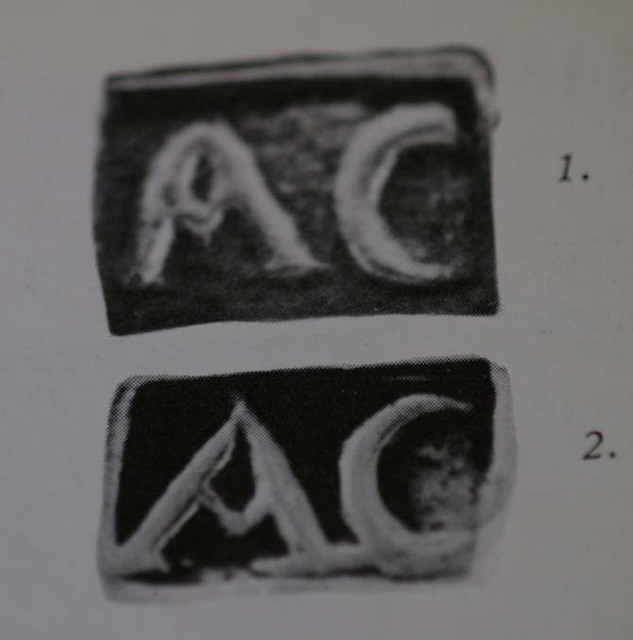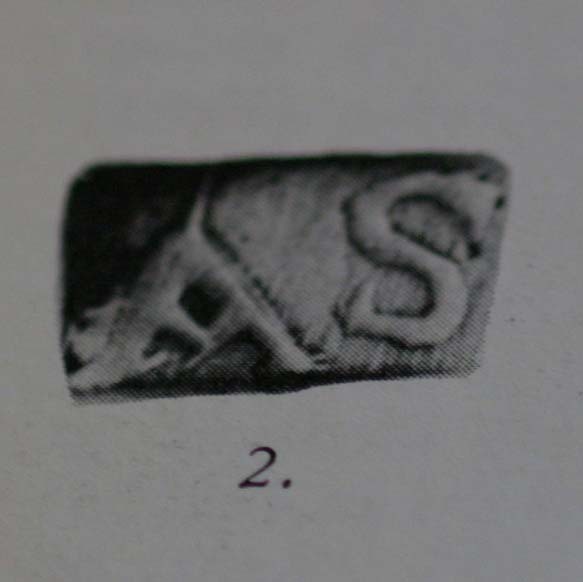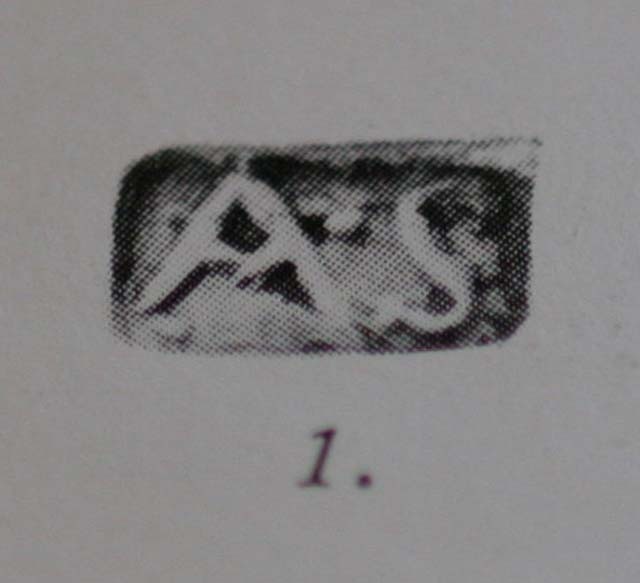|
A GLOSSARY of MILLED BANDS
|
|
| How to Post Photos |
REGISTER (click here)
|
|
A GLOSSARY of MILLED BANDS
|
|
| How to Post Photos |
REGISTER (click here)
|

|
 SMP Silver Salon Forums SMP Silver Salon Forums
  American Silver before sterling American Silver before sterling
  An American Stock clasp ? An American Stock clasp ?
|
| next newest topic | next oldest topic |
| Author | Topic: An American Stock clasp ? |
|
Clive E Taylor Posts: 450 |
  
Members may recall my delight on finding a very rare buckle – an English stock clasp pair of 1720-1740 - see Silver Salon Forum - British / Irish Sterling " Unknown Mark - RS - Presumed London around 1730" These are so rare that I think I've only ever seen one other in the last ten years. As normal having said how rare it is - another has now come up ! The ship is nicely engraved, if rather naïve and by someone who was probably not a sailor. The flag has totally baffled me and I am trying, unsuccessfully, to convince myself that it’s a British Navy ensign (which would not have the St George cross at this period). The reason I think it may be American is the makers mark – the A has a down bent cross piece which from WEV’s superb website seems to be an American form. See Index of American Marks – Abraham Schuyler and Abraham Cuyler which clearly show this feature. I have never noticed it on English silver, although I must admit to not seeing much of this periods marks. Mark is probably either AB or less likely AR, and owners initials are EL. The piece has had a hard life, the original hook having been broken off and replaced by a “blacksmith repair” crudely soldered and crimped replacement ! Hence the damage to the top of the ship picture. Age. My guess, based on English, London style would be around 1720, but if American date might be a little later if not from a major centre. Size - each of the two pieces are 41mm at the widest point Provenance – the vendor tells me it come from an old family estate (the usual story) in Pennsylvania . I know very little of ships of this period and even less on American Silversmiths. Can anyone tell me more about the ship or can identify the maker please ? IP: Logged |
|
agphile Posts: 798 |
  
As is so often the case, I cannot help with the mark or any other information. However, I am intrigued by this charming little item. Unless I have misunderstood your explanation of how these buckles work, would the ship not be pointing skywards (or earthwards) when the buckle was worn rather than sailing horizontally? IP: Logged |
|
argentum1 Posts: 602 |
  
I have seen a similar AB but just where I do not remember. I will try to dig it out provided those piles of papers and books do not fall over and crush me. One of these days I will get organized (you will notice I did not specify which day). IP: Logged |
|
Clive E Taylor Posts: 450 |
  
Aghile - you're absolutely correct - it would be at right angles to the horizon. Never dawned on me. All the others seen and recorded, including ones in copper alloy with the names of military units on them, are the same ! The stock buckle always was secured under the stock at the back of the neck and was never seen, except by the man and his valet. I now realize these clasps must again have been under the stock. Everyone has assummed this type still fastened at the front. Now it seems that they migrated to UNDER the stock at the front - which I think quite possible. But you have introduced another horrible thought - do they have another purpose ! IP: Logged |
|
Clive E Taylor Posts: 450 |
  
argentum1 - Thanks. I know the feeling ! But you are an optimist - I think in terms of years rather than days ! Seriously though can you recall if the possible AB suspect you saw was on an American item ? And is that distinctive "A" characteristically American ? IP: Logged |
|
agphile Posts: 798 |
  
A P.S. regarding the bent cross bar on the A. It is cerainly unusual on English marks. The only examples I can trace quickly are for the Arden family: a single A for Anthony Arden of Sherborne (d. 1674) and IA for John Arden of Fordington/Crewkerene (d. 1704). Source is Tim Kent's West Country Silver Spoons and their Makers. I suppose a later Arden, if there was one, could be a candidate and a ship would make sense in the West Country but I suspect you are right to be looking further afield. IP: Logged |
|
argentum1 Posts: 602 |
  
I have but a passing knowledge of non-American marks so I can not say it is American. The mark I remember is AB and was, as I remember, American. I have a large number of monographs, xeroxed workshop notes, articles and books to go through so it may take some time. IP: Logged |
|
argentum1 Posts: 602 |
  
I have but a passing knowledge of non-American marks so I can not say it is American. The mark I remember is AB and was, as I remember, American. I have a large number of monographs, xeroxed workshop notes, articles and books to go through so it may take some time. I have old copies, ready to fall apart, by Jackson, Pickford, and Banister. Doing a quick search I did not see The same type 'A' but as I said it was a quick search. IP: Logged |
|
swarter Moderator Posts: 2920 |
  
Clive, I don't want to burst anybody's bubble, but this A is not an American form. In fact there is no such thing as an American letter form from this period - early smiths operated very much in the traditions of their Old World origins - this is especially true of the New York Dutch silversmithing community to which you refer. This form of A appears on objects of Continental origin most often, and probably is a 17th C form (and earlier). I have an 18th C Scottish Grandmother clock of presumably Provincial origin bought from a dealer who got it in Glasgow - the movement bears marks of a repairman who used this form of A in his initials. I suspect its use in the 18th C is a holdover from earlier times, and would thus be most likely found on provincial objects as the makers in those areas often were conservative and slow to adopt new trends, preferring to hold to traditional forms and methods. I suppose it possible your buckle could even be of Continental origin. I can't' make anything American out of the engraved flags either, but it may be no more accurate than the ship, which looks to me to be intended to be heavier than a Frigate. IP: Logged |
|
Clive E Taylor Posts: 450 |
  
Thanks for the input Swarter - it looks that my initial thoughts that this "A" is exclusively an American form are totally incorrect. That is one of the advantage of this forum - everyone has expertise in fields uncharted by the rest of us. I think we should conclude this "A" was used in America and almost certainly Continental Europe, but was rare in England. Unless someone else can add more info !
IP: Logged |
|
Clive E Taylor Posts: 450 |
  
The ship is rather fanciful as the "artist" was manifestly not a sailor. The guns on the poop can be discounted - they are artist's license (or a naval architect's nightmare!) The remaining guns are on one deck only- hence my frigate description. Any ship of the (battle) line (modern "Battleship" )would by definition have two or three gundecks, a frigate being the next step down. But not a small warship by any means. The modern naval descendent and equivalent of a frigate is a cruiser. The notes below indicate splendidly how words change their meaning and why we should be very careful in understanding 18th century documents. The term frigate was virtually killed in the 1860's when HMS Warrior was introduced. Made of iron, she was the biggest and most powerful warship of her day. But she only had one gundeck, and too small a number of guns to be classed a ship of the line. So she was officially a frigate! Which caused problems in that her manning, rations etc were all on a scale not allowed for a frigate and had to be fudged ! The term cruiser (or ship capable of independent cruising ) replaced the word frigate in the late 19th century. After WWII it got even more confused, the USN using frigate for many years for a fast ship larger than destroyer, smaller than cruiser, the rest of NATO a ship less than destroyer, and slower . The US re-classed it's frigates to the destroyer classification in the 1970's, ending great confusion to all. Me included. In the UK the circle turned again. A Destroyer ,originally a "Torpedo Boat Destroyer", which was a fleet escort and attack craft until the 1950's, became a fleet defense ship with a predominant Anti Aircraft role, while ships with a predominant Anti-Submarine role were called frigates. In the late 1980's some frigates were now bigger than the destroyers. If this has not confused you - look at the newest RN ships - the Daring class destroyers which are dual purpose and the size of cruisers ! IP: Logged |
|
argentum1 Posts: 602 |
  
Swarter Please reference the booklet 'Albany Silver 1652-1825' p. 36. There is a mark which is listed as 'probably' Abraham Schuyler. Also on that page is an illustration of a stock buckle similar to the one in question and it is assigned to John Cuyler. Both of these references are of Albany, NY origin. I have learned a long time ago never to say never. You may well be correct but I would prefer to leave the question open for more scholarly input realizing that to date there are still far more unanswered questions than answered ones. I am in no way impugning your expertise. IP: Logged |
|
ahwt Posts: 2334 |
  
Page 33 of Albany Silver also has a mark with a similar A. The complete mark is AC and it is unidentified. It appears on a snuffbox, a funeral spoon (for someone who died in 1787), a spoon given as a gift in 1757 and one 17th style baluster-top spoon. The latter is believed to be an example of a silversmith working in an obsolete style. Does an "A" with the unusual cross member have a name? IP: Logged |
|
swarter Moderator Posts: 2920 |
  
The New York Dutch community was centered both in Manhattan and Albany. Schuyler and Cuyler were both members of that community. Remember also that in this time frame (17th/early 18th C), there was nothing "American" yet - only separate colonies of various origins - often, like the Dutch, quite insular. The only other "American" mark to use it that I can think of is one attributed to John Avery. It is not at all common. I don't know what the name might be. WEV is the typographer - if there is one he should know. [This message has been edited by swarter (edited 10-30-2008).] IP: Logged |
|
wev Moderator Posts: 4121 |
  
There is no specific name that I am aware of, but it is a common form in Germanic influenced illuminated manuscripts. IP: Logged |
|
Clive E Taylor Posts: 450 |
  
Thanks to all. I think we have to accept that this piece could be from colonial America (still my guess) , Continental Europe or even England. Could be that Argentum1 may even come across his reference. I have a similar mind - I can often remember a piece of information - but sometimes forget the source. Now I have most of my data on the computer - and the computer has taken over the job of losing it for me . [This message has been edited by Clive E Taylor (edited 11-01-2008).] IP: Logged |
|
Clive E Taylor Posts: 450 |
  
argentum1 quote: Subject to copyright - and I am not sure if the rules which in UK permit would permit such useage - would do so in the US, could you post an image of the Cuyler buckle for us please ? [This message has been edited by Clive E Taylor (edited 11-02-2008).] IP: Logged |
|
swarter Moderator Posts: 2920 |
  
quote: The buckle, which is "probably" attributable to Cuyler, is a stock buckle, of the type used on the leg, and not a clasp like the one here, which is worn at the neck, and to which it bears no resemblance whatsoever.. It has a block IC in a rectangle. There are no three letter marks of the configuration in question shown in the catalog for any Albany smiths. The catalog image is small and dark, and would not reproduce well. The buckle is similar to this one: IP: Logged |
|
Clive E Taylor Posts: 450 |
  
Thanks Swarter You are right - this type is not a stock clasp pair but a stock buckle. Stock buckles are comparatively common - the English ones having three or four studs to go into the button holes on the stock, and Continental European ones used miniature anchor fastenings. American ones use either! Both types were for attaching a man's stock - a tall cravat that fits round his neck. As i understand it the stock originally was fastened at the front of the neck by a pair of clasps - like the AB pair above. Later it was fastened as the back of the neck by a stock buckle like the one you show. These are not found in pairs - only one neck per man! In the 1760's in England both types were in use at the same time (not on the same stock of course !) as I have seen a document specifying a soldier can use either on his stock and several documents itemized stock buckles and clasps as separate items. I have no pre 1730 references to either. The item that fastened at the knee was a Breeches or Knee Buckle - first English reference seen is 1711. These are normally seen in pairs and were like a small shoe buckle, but usually with an anchor chape that fits into a button hole, rather than by a roll which fits a shoe latchet. There is a series of tiny clasp pairs dating to the late 18th century which I suspect were also used as knee fixings. As these items are easily broken I think there may have been earlier ones but few survived. The antique trade call them garter buckles, but although there are 18th century references to garter buckles I have found none for garter clasps. These evolved, confusingly into shoe clasps , mainly for clogs in the 19th century. IP: Logged |
|
argentum1 Posts: 602 |
  
   AC is page 33 and identified as Unknown AS is page 36 and identified as Abraham Schuyler I have not yet found my original source for AB IP: Logged |
|
Clive E Taylor Posts: 450 |
  
Many thanks - the form obviously was used in America - although as swarter and agphile have pointed out - not exclusively IP: Logged |
|
Clive E Taylor Posts: 450 |
  
The plot has thickened a bit. I've recently acquired a shoe buckle which from the style is typically Scottish Provincial - dating to around 1780 although the style is very much 1750 - 1760. Yes - it has the dropped cross-bar "A" ! So this "A" was also in use in Scotland. I thought it was going to be Alexander Rollo of Dundee - but the mark does not match an existing pair I have attributed to this maker. The AR on this shoe buckle , is certainly not the same mark as the AB on the clasp in question - but I suspect my AB could be AR and perhaps same maker. Jury now retire again ! IP: Logged |
All times are ET | next newest topic | next oldest topic |
  |
|
Ultimate Bulletin Board 5.46a
|
1. Public Silver Forums (open Free membership) - anyone with a valid e-mail address may register. Once you have received your Silver Salon Forum password, and then if you abide by the Silver Salon Forum Guidelines, you may start a thread or post a reply in the New Members' Forum. New Members who show a continued willingness to participate, to completely read and abide by the Guidelines will be allowed to post to the Member Public Forums. 2. Private Silver Salon Forums (invitational or $ donation membership) - The Private Silver Salon Forums require registration and special authorization to view, search, start a thread or to post a reply. Special authorization can be obtained in one of several ways: by Invitation; Annual $ Donation; or via Special Limited Membership. For more details click here (under development). 3. Administrative/Special Private Forums (special membership required) - These forums are reserved for special subjects or administrative discussion. These forums are not open to the public and require special authorization to view or post. |
|
copyright © 1993 - 2022
SM Publications
All Rights Reserved. Legal & Privacy Notices |